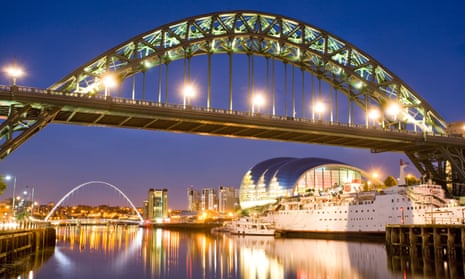Britain is a broken country badly in need of a plan to piece it back together. It is now almost 18 months since the vote for Brexit exposed the deep schism between leavers and remainers, but there is one thing on which both sides should be able to agree: the status quo is not an option.
Before anybody gets too starry-eyed about turning the clock back to June last year, it is worth running through a few relevant facts about the state of the nation on the eve of the referendum. Britain was running a record current account deficit, growth was being pumped up by an overheating housing market, factories were still producing less than before the start of the financial crisis, and people in the poorest parts of the country were being targeted with deep cuts in welfare benefits.
The national picture disguised a growing north-south divide. Only in London and the south-east are earnings, when adjusted for inflation, higher than they were 10 years ago. Research by the Centre for Cities thinktank has shown that London and its satellite cities have higher levels of productivity than Germany, but there is a 44% gap between the south-east and the less productive cities in the rest of the country.
Work by researchers at Sheffield Hallam University points out that old industrial Britain is still suffering from the consequences of the closure of factories and pits three or four decades ago. These communities have higher levels of unemployment and higher concentrations of people on disability benefit, and have suffered much more grievously from government welfare cuts. Unsurprisingly, they were also strongly in favour of leave.
North of the line that runs from the Severn estuary to the Wash, Brexit was the culmination of a 40-year process of de-industrialisation and casualisation of work. It was a protest about dead-end jobs, and about run-down communities being lorded over by London, talked down to and bossed around.
The current state of the Brexit negotiations has raised hopes among some remainers that they might still prevail in a second referendum once the terms of the deal are known. But there is no guarantee a second referendum will have a different result unless the underlying grievances are tackled. What’s more, it would be playing with fire to try to reverse the result without doing so.
Why? Imagine that the remainers have their way: a second referendum is held, and there is a different result, say 52%-48% the other way round. The clock is turned back to the Britain of 22 June 2016, life goes on as normal in London and the prosperous university towns, and the problems of the precariat are quietly forgotten. In these circumstances, the leavers of 2016 feel they have been betrayed. They grow even angrier, even more bitter. They are susceptible to the idea that the economic and political systems have both been rigged against them. Having failed to get change through the ballot box, they look to those offering less peaceful solutions.
The same challenge, of course, faces the leave camp. It has promised the people of Stoke, Hartlepool, Doncaster and all the other places that voted to leave that life will get better. So far, the only alternatives have come from the right: either a low-tax, low-regulation Singapore-on-Thames model, or Theresa May’s empty promises to those “just about managing”. It is time for the left to come up with some ideas.
Here are a few to get the ball rolling. Unlike the overcrowded south-east, the north is not short of homes, but its housing stock is often run down and energy inefficient. So there should be a nationwide programme to improve insulation, starting with cities in the north. Such a scheme would cut fuel bills, reduce carbon emissions and provide well-paid jobs for local people.

This, though, would not be enough to reverse decades of the hollowing out of local economies. For that to happen, the state needs a new national investment bank, and to use it to channel funds into traditional manufacturing sectors – such as engineering, and food and drink – where they need modernising, and to identify the growth sectors of the future.
Industrial strategy, after a hiatus lasting more than 30 years, is back in vogue and a government white paper is due out next week. Its aim should be to make sure Britain excels in the fourth industrial revolution: developments in artificial intelligence, nanotechnology, biotechnology, materials science, 3D printing and quantum computing that are going to transform the global economy. The UK is well placed to flourish in many of these areas, but there is a danger that the benefits will go overwhelmingly to the golden triangle of London, Oxford and Cambridge.
To prevent this happening, the government should identify a university in each of the big northern cities to take the lead in one of the new technologies: driverless cars in Birmingham, say, or new materials in Manchester. Academic funding, tax breaks, state aid and public procurement should all be used to establish industrial clusters and develop domestic supply chains.
If the north is to thrive, it will need substantial improvements in its infrastructure. The money that has been earmarked for the HS2 rail link, connecting London with the north, should be spent instead on HS3 – linking Liverpool, Manchester, Leeds, Sheffield and Hull with Newcastle. As currently planned, HS2 is an expensive way of sucking talented people out of the north. HS3 would encourage them to stay.
Tackling the north’s productivity gap also means addressing its skills gap. One reason companies are reluctant to move out of the south-east is that they are unsure they can get the people they want: schools in the north and Midlands lag behind those in the south; levels of adult literacy and numeracy are poor; and there is a mismatch in further education between the courses being provided and the skills employers are demanding. Steps are already being taken to attract talented teachers, but clearly more needs to be done, such as greater investment in adult and further education, and a salary premium for teachers prepared to move north.
The north resents the south and with good reason. There was a time in the 19th century when the balance of power was in favour of the big northern cities. Nowadays, London is at the centre of everything: the country’s financial hub, media capital and centre of political power. So some bold decentralisation is needed: allow local governments to raise and keep more of their own money; ensure that a new national investment bank is based not in Canary Wharf, but on the banks of the Mersey or the Humber; and move parliament, as the MP Frank Field suggests, to Leeds or Manchester.
Above all, be bold. It normally takes exceptional times – witness 1945 or 1979 – to prompt radical change in Britain. Brexit is just such a moment, and its potential should not be wasted. Remain or leave, a package of housing, jobs, infrastructure, skills and devolution should be put together to reboot Britain’s economy and heal the geographical divide. It would be the New Deal for the North.

